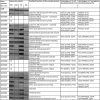Gamma-Glutamylpolyamine Synthetase GlnA3 Is Involved in the First Step of Polyamine Degradation Pathway in Streptomyces coelicolor M145
- PMID: 28487688
- PMCID: PMC5403932
- DOI: 10.3389/fmicb.2017.00726
Gamma-Glutamylpolyamine Synthetase GlnA3 Is Involved in the First Step of Polyamine Degradation Pathway in Streptomyces coelicolor M145
Abstract
Streptomyces coelicolor M145 was shown to be able to grow in the presence of high concentrations of polyamines, such as putrescine, cadaverine, spermidine, or spermine, as a sole nitrogen source. However, hardly anything is known about polyamine utilization and its regulation in streptomycetes. In this study, we demonstrated that only one of the three proteins annotated as glutamine synthetase-like protein, GlnA3 (SCO6962), was involved in the catabolism of polyamines. Transcriptional analysis revealed that the expression of glnA3 was strongly induced by exogenous polyamines and repressed in the presence of ammonium. The ΔglnA3 mutant was shown to be unable to grow on defined Evans agar supplemented with putrescine, cadaverine, spermidine, and spermine as sole nitrogen source. HPLC analysis demonstrated that the ΔglnA3 mutant accumulated polyamines intracellularly, but was unable to degrade them. In a rich complex medium supplemented with a mixture of the four different polyamines, the ΔglnA3 mutant grew poorly showing abnormal mycelium morphology and decreased life span in comparison to the parental strain. These observations indicated that the accumulation of polyamines was toxic for the cell. An in silico analysis of the GlnA3 protein model suggested that it might act as a gamma-glutamylpolyamine synthetase catalyzing the first step of polyamine degradation. GlnA3-catalyzed glutamylation of putrescine was confirmed in an enzymatic in vitro assay and the GlnA3 reaction product, gamma-glutamylputrescine, was detected by HPLC/ESI-MS. In this work, the first step of polyamine utilization in S. coelicolor has been elucidated and the putative polyamine utilization pathway has been deduced based on the sequence similarity and transcriptional analysis of homologous genes expressed in the presence of polyamines.
Keywords: GS-like enzyme; GlnA3; Streptomyces coelicolor; gamma-glutamylpolyamine synthetase; nitrogen assimilation; polyamine utilization.
Figures











Similar articles
-
GlnA3Mt is able to glutamylate spermine but it is not essential for the detoxification of spermine in Mycobacterium tuberculosis.J Bacteriol. 2025 Feb 20;207(2):e0043924. doi: 10.1128/jb.00439-24. Epub 2025 Jan 30. J Bacteriol. 2025. PMID: 39882905 Free PMC article.
-
A Second Gamma-Glutamylpolyamine Synthetase, GlnA2, Is Involved in Polyamine Catabolism in Streptomyces coelicolor.Int J Mol Sci. 2022 Mar 29;23(7):3752. doi: 10.3390/ijms23073752. Int J Mol Sci. 2022. PMID: 35409114 Free PMC article.
-
Initial Metabolic Step of a Novel Ethanolamine Utilization Pathway and Its Regulation in Streptomyces coelicolor M145.mBio. 2019 May 21;10(3):e00326-19. doi: 10.1128/mBio.00326-19. mBio. 2019. PMID: 31113893 Free PMC article.
-
Poly- and Monoamine Metabolism in Streptomyces coelicolor: The New Role of Glutamine Synthetase-Like Enzymes in the Survival under Environmental Stress.Microb Physiol. 2021;31(3):233-247. doi: 10.1159/000516644. Epub 2021 May 27. Microb Physiol. 2021. PMID: 34044403 Review.
-
Polyamine metabolism.Digestion. 1990;46 Suppl 2:319-30. doi: 10.1159/000200405. Digestion. 1990. PMID: 2262065 Review.
Cited by
-
Crystal structures of free and ligand-bound forms of the TetR/AcrR-like regulator SCO3201 from Streptomyces coelicolor suggest a novel allosteric mechanism.FEBS J. 2023 Jan;290(2):521-532. doi: 10.1111/febs.16606. Epub 2022 Sep 2. FEBS J. 2023. PMID: 36017630 Free PMC article.
-
Novel Glutamate-Putrescine Ligase Activity in Haloferax mediterranei: A New Function for glnA-2 Gene.Biomolecules. 2021 Aug 4;11(8):1156. doi: 10.3390/biom11081156. Biomolecules. 2021. PMID: 34439822 Free PMC article.
-
The efflux pumps Rv1877 and Rv0191 play differential roles in the protection of Mycobacterium tuberculosis against chemical stress.Front Microbiol. 2024 Mar 4;15:1359188. doi: 10.3389/fmicb.2024.1359188. eCollection 2024. Front Microbiol. 2024. PMID: 38516013 Free PMC article.
-
Metabolic diversification of nitrogen-containing metabolites by the expression of a heterologous lysine decarboxylase gene in Arabidopsis.Plant J. 2019 Nov;100(3):505-521. doi: 10.1111/tpj.14454. Epub 2019 Aug 27. Plant J. 2019. PMID: 31364191 Free PMC article.
-
GlnA3Mt is able to glutamylate spermine but it is not essential for the detoxification of spermine in Mycobacterium tuberculosis.J Bacteriol. 2025 Feb 20;207(2):e0043924. doi: 10.1128/jb.00439-24. Epub 2025 Jan 30. J Bacteriol. 2025. PMID: 39882905 Free PMC article.
References
-
- Algranati I. D., Echandi G., Garcia-Patrone M., Gonzalez N. S., Goldemberg S. H. (1976). Polyamines, equilibrium between ribosomal particles and protein synthesis in bacteria. Arch. Biol. Med. Exp. 10 49–60. - PubMed
-
- Amin R., Franz-Wachtel M., Tiffert Y., Heberer M., Meky M., Ahmed Y., et al. (2016). Post-translational serine/threonine phosphorylation and lysine acetylation: a novel regulatory aspect of the global nitrogen response regulator GlnR in S. coelicolor M145. Front. Mol. Biosci. 3:38 10.3389/fmolb.2016.00038 - DOI - PMC - PubMed
LinkOut - more resources
Full Text Sources
Other Literature Sources

